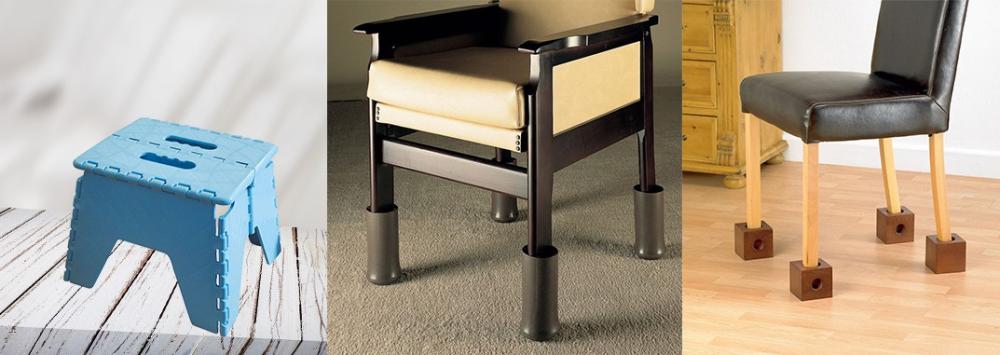
Getting On with Arthritis
Sally Madeley-Carr, OT23 Jul 2021
In later life, many people may find that they have some form of arthritis in their joints, which makes straightforward movements somewhat painful. This discomfort can affect dexterity, sitting, standing and mobility.
Managing arthritis is paramount to quality of life and to maintaining a comfortable level of continued independence.
Whilst ageing might have, in the not too distant past, affected quality of life quite severely, technology and equipment available in today's world allows us to limit the effect of ageing on everyday life.
Arthritis
Arthritis is a condition which many people will experience in their later years. It presents itself as tenderness, stiffness and swelling in one or more of the joints.
Arthritis occurs when the body's immune system attacks the soft tissue (synovium) in the joints, which then leads to pain and restricted movements around the affected joint.
Stiffness can occur after heavy work or strenuous exercise but can also be as a result of prolonged sitting.
Arthritis pain can feel like a burning sensation but also like a dull ache.
The most common types of arthritis are rheumatoid arthritis and osteoarthritis.
Rheumatoid arthritis can begin at a very early age (in children) but is more often diagnosed between the ages of thirty and sixty.
Cartilage is a form of padding between joints, which stops bones rubbing together and osteoarthritis begins when this tissue becomes ragged or starts to wear away.
Osteoarthritis is one of the most common causes of physical disability in the elderly.
Before the age of forty five, more men develop osteoarthritis than women though, in later years, it is women who are more likely to develop this form of arthritis than men.
Ways to Manage Arthritis
Regular exercise is a way of keeping the muscles strong around the joints, by keeping the pressure off the bones and / or the joint. Regular exercise can also help reduce fatigue.
Arthritis can be slowed down, or managed, not only by exercise but also by:-
- keeping your weight under control, as excessive weight puts pressure on weight-bearing joints, such as the hips and knees
- living a healthy lifestyle
- controlling your blood sugar levels (healthy eating, drinking plenty of water and also managing stress levels) regular stretching e.g. yoga, a practice which leaves you feeling stronger and more flexible, as well as more mentally focussed
- a healthy diet - steering clear of processed fast foods, alcohol and sugary foods
- eating fish at least twice a week - fatty fish, such as salmon, tuna, mackerel and sardines, are the best source of omega -3, which can help reduce inflammation
- stopping smoking
- squeezing a stress ball, which can improve grip and relieve pain for those with hand osteoarthritis
- sitting comfortably, so as to take pressure off affected joints.
Dexterity
Weakened grip can make people feel unsafe on their feet, as they no longer have that safeguard of holding sturdily on to chairs, tables, or worktops, when walking.
Life is quite often lived in the kitchen and so managing once easy tasks has been well covered with appropriate aids:-
- can pull tin openers designed to open ring pull tins, even with reduced strength
- cutlery with fatter handles, or with Velcro straps, which keep the cutlery in one's hand, even if the user has a weaker grip. The Velcro fastener also houses a small pocket, into which the knife, fork or spoon handle can rest whilst in use
- two-handled cups share the weight between both hands
- a kettle tipper stand supports the kettle while tilting it towards the teapot or cup
- an under counter bottle and jar opener, which needs only one hand to perform the task
- a tea trolley on wheels, which helps you get drinks and meals safely to the table, without the fear of losing grip on hot items.
Weakened grip can lead to loss of confidence in carrying out everyday tasks, so finding the right aid addresses the need.
Sitting and Standing
Sitting
Our height can dictate the right seat height for us, as the length of our legs will determine the best seat pad height which will support our upper legs along their whole length.
The correct depth of seat pad will support our upper legs right along to the knee joint, allowing the lower leg to bend appropriately at the knee and to comfortably meet the floor.
If a seat pad height is either too high or too low, it will make getting into a standing position much more difficult which, exacerbated by arthritis, could prove somewhat cumbersome and could lead to a fall.
Should the seat pad of your favourite chair be a little too high for you, a footstool can help shorten the distance for you between your foot and the floor.
When purchasing a footstool, buy a folding footstool, as it can be folded away when not in use and, when folded, it is easier to carry, as well as store.
Standing
Difficulty in standing from a chair can also be because of stiffness in the back, weakness in the legs and bad balance.
If arthritis is in the leg joints, the legs may prove too weak to take the individual's weight and a walking frame may be needed for moving independently around the house.
Walking frames take the weight off the legs and transfer it to the arms and shoulders.
A sturdy, metal, standing aid frame can fit against a chair, bed, car, or toilet. Its adjustable height makes it suitable for people of all heights to comfortably reach a stable standing position.
Leg pain could also suggest excess fluid in the leg veins, so always make your local GP the first port of call.
Getting In and Out of a Chair
Getting the right seat height can be achieved in several ways:-
- Extra seat pad height. A booster cushion can add an extra four inches (10 cms.) of height to the user's favourite chair.
- The foam layers in a booster cushion allow the user to get onto his / her feet, as leaning forward encourages the spongy layers to re-inflate and enables the user to move up to a new height.
- Raising the chair. Chair raisers are designed to place the chair legs into fitted shapes (liken it to wearing heeled boots), in which the chair legs can be raised up to six inches (15 cms.) from the ground. For taller people with longer legs, chair raisers allow the thighs to be better supported, rather than the knees rising above the seat pad and creating difficulty in getting into a standing position.
- A folding footstool. For the person with shorter legs, a folding footstool can allow the user's feet to touch down onto the stool, rather than them hanging limply in the air, whilst also causing pressure and numbness on the thighs.
- Riser recliner chairs. Riser recliner chairs can do the work of sitting and standing for you. At the press of a button, electrically-powered chairs can tilt the user into a standing position and also lower the user into a sitting position.
- Riser recliner chairs offer the user many adjustment choices, getting the best position to suit the user in that moment.
- Getting the chair into that right position can help take the pressure of aching joints, relieve back pain and reduce arthritis pain.
- Riser recliner chairs take away the need to ask for support in standing and so help to maintain self respect and independence.
Mobility
Walking and arthritis don't come together comfortably.
Walking frames can support the upright body when walking, or when simply standing.
Walking frames are available with or without wheels.
Walkers without wheels would command appropriate upper body strength, to regularly lift the frame forward, ready for the next step forward.
Without wheels, a walker may have three or four legs. In tight spaces, the three-legged walker offers more manoeuvrability.
Frames with wheels need less upper body strength, as the wheels propel the walker forward.
Frames with wheels can be used both indoors and outdoors, helping to maintain an adequate level of independence with most everyday tasks.
For outside use, the four wheel frame offers better stability than the three wheel frame, as it can move more easily over bumpy terrain.
Moving around the kitchen and walking in the garden can both benefit from appropriately located grab rails, just like climbing stairs is supported by the standard handrail.
Summary
Today's technology lessens the blow of arthritis on our everyday activities.
Remember that leg pain may also be as a result of excess fluid in the leg veins, so always make your local GP the first port of call.
Chair raisers and folding footstools are more economical ways of supporting comfortable sitting and standing. The cost of purchasing a riser recliner chair can be quite prohibitive.
When purchasing a walker, always test them out before deciding which one to purchase.
If you are suffering significant discomfort or find yourself unable to perform everyday activities, a local authority occupational therapist should be able to help.
They will advise on home adaptations or other other equipment or steps available to overcome practical problems.

Sally Madeley-Carr, OT
Sally qualified as an Occupational Therapist in 1996 and is a well-respected professional in the field of rehabilitation equipment and living aids. She has worked in private practice and within the NHS, developing a broad experience with adults and children. Click here for Sally's registration with the Health and Care Professions Council. The HCPC regulates health, psychological and social work professionals in the UK.